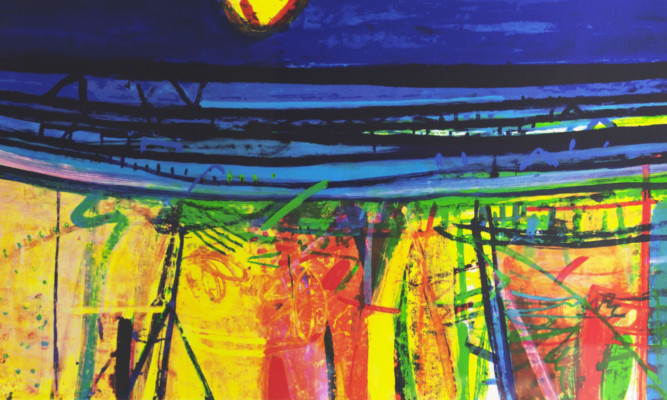The work of one of Scotland’s most revered contemporary artists, Barbara Rae, is currently on display in St Andrews. Caroline Lindsay finds out more.
Barbara Rae is an internationally renowned artist and St Andrews University’s extensive collection of her work, alongside paintings loaned to the university for the purpose of the exhibition, are testimony to her extraordinary talent and versatility.
The exhibition Barbara Rae RA: Place and Process focuses on her recent work and is a vibrant showcase of colourful and abstract acrylic paintings and collages, prints and etchings and a special tapestry designed by the artist. Curated by Museum Collections, it’s open to the public until December 13, in both the Gateway Galleries and the School of Art History.
Barbara, whose contributions to art were recognised in the form of a CBE in 1999, is an honorary graduate of the university, having been made a Doctor of Letters in 2008. She was elected to the Royal Academy of Arts in London in 1996 and is also a member of the Royal Fine Art Commission and the Royal Scottish Academy.
Born in Falkirk in 1943, Barbara grew up in Crieff and was encouraged by her art teachers at school. She studied at Edinburgh College of Art from 1961 to 1965. “A lot of it was very hard work some people are born with the facility to draw but others have to work at it, and I learned and matured over the years, experimenting with painting and developing ideas,” she recalls. At college she was awarded a travel scholarship, which took her to France and Spain in 1966.
“That trip to the Basque area of Spain was quite a revelation,” she says. “The change of culture and light from what I was used to in Scotland was breathtaking and was the beginning of my relationship with Spain I go there as often as I can. I don’t like being called a landscape painter I’m not interested in a bunch of rocks or a field. It’s the culture and history of a place that fascinate and inspire me. People say: ‘Why don’t you go to India?’ but it would take me 10 years to absorb the culture of India, so that doesn’t tempt me at all.”
After she graduated she attended Moray House College of Education and taught in Edinburgh, before going on to lecture in drawing, painting and printmaking at Aberdeen College of Education and then in drawing and painting at Glasgow School of Art from until 1996. Her first solo show was held in 1967 in Edinburgh and her work has been included in many solo and group exhibitions both nationally and internationally.
Barbara, who lives in Edinburgh, said: “I am delighted to be associated again with the University St Andrews. It was just fantastic to receive my honorary degree, a wonderful honour. This exhibition was an irresistible invitation although I refused others for this year. The exhibition gives a reasonably comprehensive overview of my prints these last two years, and I hope students and visitors can gain pleasure from my work and images.
“We are living in exciting political times with Scotland asserting its international credentials and any good artist naturally feels their work of international interest.
“I hope people will begin to understand my love of culture. In the last 10 to 12 years I’ve explored the history of Ireland and in particular County Mayo, as well as France and Spain. I don’t go to paint pretty pictures I want to know about the history of the region.
“The exhibition is mostly prints but there are one or two originals too. I’d like visitors to be inspired to try printmaking themselves and be excited by the process you don’t have to be an artist to do it, it’s a working practice that everyone can do from age two upwards!”
Barbara finds it hard to pick a favourite. “I’d probably go along the paintings, saying: ‘That’s my favourite, no, that’s my favourite!’” she laughs. “The fact is, they’re all related to each other, part of a family that relates to my history.”
So what’s next for Barbara? “I’m just finishing a series of pictures to do with a specific area of County Mayo, where a prehistoric farm that was under a bog has been uncovered. When I went there in February I decided that I was going to concentrate on that small square mile. That’s nearly finished and then I’ll be exhibiting some large-scale carborundum prints with three other artists at the Glasgow Print Studio in November.”
